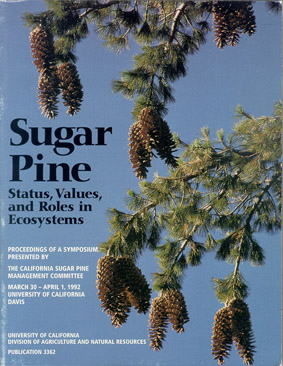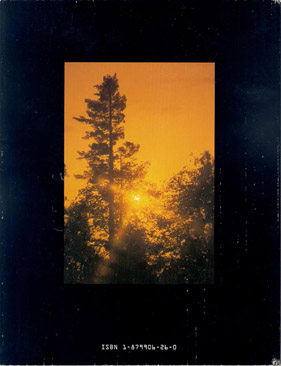1 November 2001
Bohun B. Kinloch, Jr., Melissa Marosy & May E. Huddleston (Ed.)
SUGAR PINE,
Status, Values and Roles in Ecosystems
 Proceedings of a Symposium, The California Sugar Pine Management Committee, March 30 - April 1, 1992, University of California, Davis, Division of Natural Resources, Publication 3362, USA, 225 pages, color & black-and-white photographs, tables, maps, bibliographies
Proceedings of a Symposium, The California Sugar Pine Management Committee, March 30 - April 1, 1992, University of California, Davis, Division of Natural Resources, Publication 3362, USA, 225 pages, color & black-and-white photographs, tables, maps, bibliographies
ISBN 1-879906-26-0
PREFACE
This symposium was motivated by a concern perceived by both resource professionals and lay public alike that sugar pine as a species might be in imminent jeopardy from the introduced disease white pine blister rust. Even though the rust had been on the attack for over half a century an attitude of complacency prevailed. It was thought that the epidemic had stabilized and in many areas of the species' range the problem would not be serious. In the mid- and late 1980s, however, heavy infection suddenly began to appear where it had never been seen before in parts of the central Sierra Nevada on sugar pine, and also at high elevations on western white and even whitebark pines. The effects were especially lethal on regeneration, both natural and artificial.
What was happening? Did this mean that sugar pine was in greater danger than had been imagined all along? Were management tools and concepts adequate to meet the challenge? There was concern that no one knew the magnitude of the crisis, or what to do about it.
 The California Sugar Pine Management Committee, a diverse ad hoc group composed of land managers, researchers, academics, conservationists, and others, met in 1989 to discuss the situation. It was soon recognized that blister rust was not the only problem facing sugar pine, and that much of what was known about the biology of the species was in scattered reports, filed data, and individuals' memories. There was an evident need to gather under one cover the most current and scientifically valid information available on the status, value, and roles of sugar pine in ecosystems, to serve as a guide for setting policy, management strategy, and research direction. The Symposium and these Proceedings were logical consequences of this reasoning.
The California Sugar Pine Management Committee, a diverse ad hoc group composed of land managers, researchers, academics, conservationists, and others, met in 1989 to discuss the situation. It was soon recognized that blister rust was not the only problem facing sugar pine, and that much of what was known about the biology of the species was in scattered reports, filed data, and individuals' memories. There was an evident need to gather under one cover the most current and scientifically valid information available on the status, value, and roles of sugar pine in ecosystems, to serve as a guide for setting policy, management strategy, and research direction. The Symposium and these Proceedings were logical consequences of this reasoning.
Anyone who probes these pages more than casually will soon recognize how limited the current knowledge base is. Nonetheless, we hope that the information provided here will expose critical gaps in knowledge as well as provide a baseline upon which to build, and thus serve as an invaluable resource for those interested in the study, management, and conservation of sugar pine.
Bohun B. Kinloch, Jr., Program Chair
Melissa Marosy, Symposium Chair
ACKNOWLEDGMENTS
Sustaining Sponsors
USDA Forest Service, Pacific Southwest and Northwest Regions
USDA Forest Service, Pacific Southwest Research Station
USDI Bureau of Land Management, Oregon State Office
Pacific Gas and Electric Co.
USDI Bureau of Indian Affairs, Forestry Branch
California Native Plant Society
Fruit Growers Supply Go.
Roseburg Resources
Jones and Stokes Associates, Inc.
California Department of Forestry and Fire Protection
Northern California Society of American Foresters
Sponsors
Association of Consulting Foresters
California Polytechnic University San Luis Obispo,
Natural Resources Management Department
California Licensed Foresters Association
California Tree Improvement Association
Stanford University Center for Conservation Biology
Hoopa Valley Business Council
National Audubon Society
The Nature Conservancy
Oregon Department of Forestry
The Sierra Club
California Lands Commission
University of California Berkeley, Cooperative Extension Service
USDI National Park Service, Western Regional Office
The Wilderness Society
CONTENTS
| iii | | Preface, Acknowledgments
|
| 1 | | Is a Little Knowledge a Good Thing?
John A. Helms
|
| |
Part 1 - VALUES
|
| 10 | | Sugar Pine in the History of the West Coast
Robert W. Cermak
|
| 22 | | Inventory Trends and Values of Sugar Pine
Gerald A. Ahlstrom
|
| |
Part 2 - ECOLOGY
|
| 28 | | Silvics of Sugar Pine: Clues to Distribution and Management
William W. Oliver
|
| 34 | | Endemic Insect Pests and Diseases of Sugar Pine
George T. Ferrell and Robert F. Scharpf
|
| 38 | | Role of Sugar Pine in the Mixed Evergreen Forests of the Klamath Region of Northwest California
Dale Thornburgh
|
| 38 | | Ecology of Sugar Pine in Late Successional Mixed-Conifer Forests in the Northern Sierra Nevada and Southern Cascades
Jo Ann Fites
|
| 39 | | Dynamics of Sugar Pine and Associated Species Following Non-Stand-Replacing Fires in White Fir-Dominated Mixed-Conifer Forests
Neil G. Sugihara and Joe R. McBride
|
| 45 | | Uses of Sugar Pine by Cavity-Nesting Birds
Thomas M. Jimerson
|
| |
Part 3 - GENETICS
|
| 54 | | Genotype-Environment Interaction in Common Garden Tests of Sugar Pine
James L. Jenkinson
|
| 75 | | COLOR PLATES
|
| 83 | | Genetic Variation in the Growth of Sugar Pine Progenies in California Plantations
Jay H. Kitzmiller and Paul Stover
|
| 99 | | Patterns of Variation in Isozymes of Sugar Pine
M. Thompson Conkle
|
| 100 | | Xylem Monoterpenes of Pinus lambertiana
Richard H. Smith and Lula E. Greene
|
| |
Part 4 - BLISTER RUST AND THE BASIS FOR RESISTANCE
|
| 112 | | Spread and Intensification of Blister Rust in the Range of Sugar Pine
Richard S. Smith, Jr.
|
| 119 | | Climatic Factors that Influence the Spread of White Pine Blister Rust
Francis M. Fujioka
|
| 125 | | Mechanisms and Inheritance of Resistance to Blister Rust in Sugar Pine
Bohun B. Kinloch, Jr., and Dean Davis
|
| 133 | | Variation in Virulence in Gronartium ribicola: What Is the Threat?
Bolitin B. Kinloch, Jr., Dean Davis, and Gayle E. Dupper
|
| 137 | | Ecotypes of Blister Rust arid Management of Sugar Pine in California
Geral I. McDonald
|
| 148 | | Sugar Pine as a Model for the Molecular and Biochemical Mechanism of White Pine Blister Rust Resistance
Abul K.M. Ekramoddoullah and Bolvin B. Kinloch, Jr.
|
| |
Part 5 - MANAGEMENT AND CONTROL OF BLISTER RUST
|
| 152 | | Improving Nursery Management of Sugar Pine in the Sierra Nevada
James L. Jenkinson and Arthur H. McCain
|
| 162 | | The Sugar Pine Program for Development of Resistance to Blister Rust in the Pacific Southwest Region
Safiya Samman and Jay H. Kitzmiller
|
| 171 | | Developing Resistance to White Pine Blister Rust in Sugar Pine in Oregon
Richard A. Sniezko
|
| 179 | | Silvicultural Methods of Limiting Blister Rust in Sugar Pine
Gregg A. DeNitto
|
| 185 | | Utilizing Naturally Occurring Blister Rust Resistance in Sugar Pine at Mountain Home Demonstration State Forest
David Dulitz, David Adams, Jeanne Martin, and Lloyd Stahl
|
| 190 | | Conservation of Biodiversity in Sugar Pine: Effects of the Blister Rust Epidernic on Genetic Diversity
Constance I. Millar, Bohun B. Kinloch, Jr., and Robert D. Wesfall
|
| 200 | | Conservationists' Perspective on Sugar Pine Management
James Jokerst and Mary Meyer
|
| 201 | | The Land Manager's Viewpoint: A Panel Report
Paul A. Violett, Barry K. Ford, David F. Thomas, Nancy A. Gard, Harvey J. Koester, and Jan W. van Wagtendonk
|
| |
SUMMARY AND SYNTHESIS
|
| 216 | | Reflections on the Symposium William J. Libby
|
| 222 | |
POSTER ABSTRACTS
|
| 225 | |
INDEX OF AUTHORS
|
1 November 2001
 The California Sugar Pine Management Committee, a diverse ad hoc group composed of land managers, researchers, academics, conservationists, and others, met in 1989 to discuss the situation. It was soon recognized that blister rust was not the only problem facing sugar pine, and that much of what was known about the biology of the species was in scattered reports, filed data, and individuals' memories. There was an evident need to gather under one cover the most current and scientifically valid information available on the status, value, and roles of sugar pine in ecosystems, to serve as a guide for setting policy, management strategy, and research direction. The Symposium and these Proceedings were logical consequences of this reasoning.
The California Sugar Pine Management Committee, a diverse ad hoc group composed of land managers, researchers, academics, conservationists, and others, met in 1989 to discuss the situation. It was soon recognized that blister rust was not the only problem facing sugar pine, and that much of what was known about the biology of the species was in scattered reports, filed data, and individuals' memories. There was an evident need to gather under one cover the most current and scientifically valid information available on the status, value, and roles of sugar pine in ecosystems, to serve as a guide for setting policy, management strategy, and research direction. The Symposium and these Proceedings were logical consequences of this reasoning.
 Proceedings of a Symposium, The California Sugar Pine Management Committee, March 30 - April 1, 1992, University of California, Davis, Division of Natural Resources, Publication 3362, USA, 225 pages, color & black-and-white photographs, tables, maps, bibliographies
Proceedings of a Symposium, The California Sugar Pine Management Committee, March 30 - April 1, 1992, University of California, Davis, Division of Natural Resources, Publication 3362, USA, 225 pages, color & black-and-white photographs, tables, maps, bibliographies